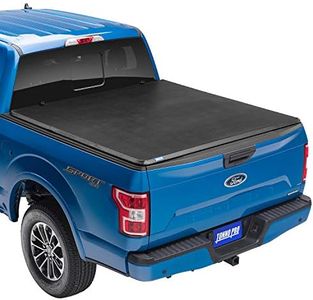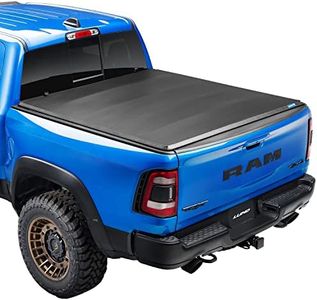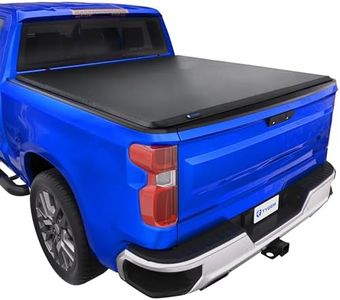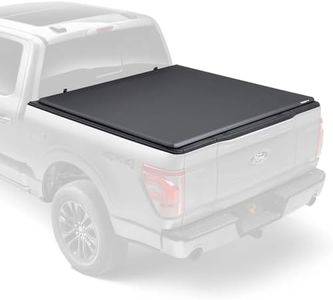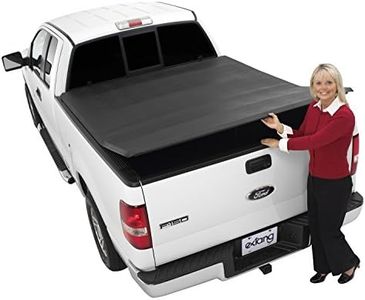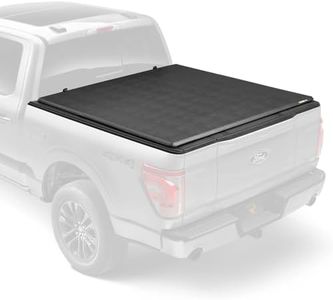We Use CookiesWe use cookies to enhance the security, performance,
functionality and for analytical and promotional activities. By continuing to browse this site you
are agreeing to our privacy policy
10 Best Tri Fold Tonneau Covers
From leading brands and best sellers available on the web.Buying Guide for the Best Tri Fold Tonneau Covers
Choosing the right tri-fold tonneau cover for your truck can make a big difference in how you use your vehicle and protect your cargo. Tri-fold covers are popular because they offer a good balance between accessibility, security, and weather protection, folding up in three sections for easy use. Before making a decision, consider how you plan to use your truck bed, how often you'll need quick access, and what type of items you'll typically transport. Understanding the key specifications will help match your needs to the features available.MaterialThe material of a tri-fold tonneau cover impacts its durability, weight, security, and weather resistance. Common materials include vinyl, aluminum, or composite plastics. Vinyl covers are lighter and often more affordable, making them easy to handle but potentially less durable in extreme weather or against theft. Aluminum and composite covers are sturdier, offering better protection and more secure locking but they can weigh more and sometimes require more effort to handle. If you need maximum security and weather defense, go for hard materials. If ease of use and light handling matters most, a soft material might suit you better.
Locking MechanismThe locking mechanism helps protect your cargo from theft and keeps the cover securely in place. Some tri-fold covers rely on a latch system that integrates with your truck's tailgate lock, while others have their own separate locks or clamps. Look for covers that sync with your existing truck lock for convenience and security. If you frequently carry valuable gear, choosing a cover with a reliable, integrated locking system will keep your items safer.
Weather SealingWeather sealing refers to how well the cover keeps out rain, snow, and dust. Good weather seals use foam, rubber, or specially designed edges to keep elements out of your truck bed. Less effective seals can let water seep in around the edges or hinges, risking damage to your cargo. If you live in an area with heavy rain or snow, ensure the cover has a reputation for water-tightness and robust seals.
Installation MethodThe installation method determines how easily you can put on or take off the cover, often using clamps or bolt-on mounts. Some covers are designed for no-drill, quick-installation, making them simple to add or remove as needed. Others may require tools or a more permanent fit. If you want to regularly remove the cover for hauling larger items, pick a model with a tool-free, clamp-on installation.
Profile HeightProfile height is how much the cover sticks up above your bed rails. Low-profile covers sit almost flush, giving a sleek look and potentially better aerodynamics. Standard or higher-profile covers might offer extra strength or easier folding but can be more visible and slightly affect the lines of your truck. If you prefer a subtle appearance or want to reduce wind drag, a low-profile cover is a good choice.
Weight CapacityWeight capacity refers to how much weight the closed cover can support without bending or damage. Hard tri-fold covers can sometimes hold significant weight (such as snow or small items placed on top), while soft covers are mainly meant for keeping items underneath. If you expect snow accumulation or want to occasionally set things on top, pay attention to this rating and choose a cover that matches your needs.
Bed AccessBed access describes how much of your truck bed you can reach when the cover is installed and folded. Tri-fold covers generally allow you to fold up two or all three sections. Some may block access to a portion of the bed even when folded. If you often haul large or awkward loads, ensure the cover folds up fully and stays secured against the cab for maximum access.

